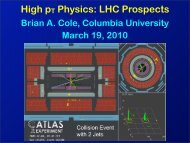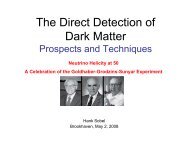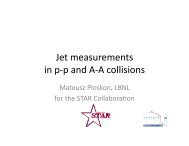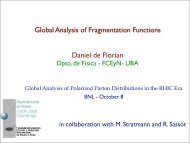One flavor QCD Abstract - BNL theory groups - Brookhaven National ...
One flavor QCD Abstract - BNL theory groups - Brookhaven National ...
One flavor QCD Abstract - BNL theory groups - Brookhaven National ...
You also want an ePaper? Increase the reach of your titles
YUMPU automatically turns print PDFs into web optimized ePapers that Google loves.
of this term occur when the product Σh is in the group center. For the case M − m positive, there<br />
is a degenerate pair of minima occurring at<br />
Σ = e ±2πi/3 h. (18)<br />
We see that Eq. (16) has two competing terms, one having a unique minimum at Σ = I and the<br />
other having two degenerate ground states at the above complex values. For the degenerate case<br />
with M = m, only the first term is present and the vacuum is unique. However when m = −M only<br />
the second term is present with its corresponding pair of degenerate vacua. Somewhere between<br />
these points must lie a critical value m c where the situation shifts between a unique and a doubly<br />
degenerate vacuum.<br />
To determine the critical mass, consider matrices of form<br />
Σ = e iφΓ (19)<br />
where<br />
For these the potential is<br />
⎛<br />
−2 0<br />
⎞<br />
0<br />
⎜<br />
Γ = ⎝ 0 1<br />
⎟<br />
0⎠. (20)<br />
0 0 1<br />
V(φ) ∝ −mcos(2φ) − 2M cos(φ). (21)<br />
The extremum at φ = 0 continuously changes from a minimum to a maximum at m c = −M/2, the<br />
desired critical point. As discussed at the beginning of this section, it occurs at a negative value<br />
of m. The only dimensional scale present is M, to which the result must be proportional. This<br />
analysis immediately generalizes to larger <strong>flavor</strong> <strong>groups</strong>; for N f <strong>flavor</strong>s divided into a set of N f −1<br />
of mass M and one of mass m we have m c =<br />
N −M<br />
f −1<br />
. As M becomes much larger than the scale of<br />
<strong>QCD</strong>, Λ qcd , it is expected that the latter will replace M in setting the scale for the critical mass.<br />
This discussion suggests that a similar phenomenon should occur on the lattice with one <strong>flavor</strong><br />
of Wilson fermion. Here the bare mass is controlled by the hopping parameter. As the hopping<br />
parameter increases, the fermion mass decreases. In the plane of the gauge coupling and hopping<br />
parameter, a critical line should mark where the above parity breaking begins. In the lattice context<br />
the possibility of such a phase was mentioned briefly by Smit [13] and later extensively discussed<br />
by Aoki [14] and Aoki and Gocksch [15]. The latter papers also made some rather dramatic<br />
predictions for the breaking of both parity and <strong>flavor</strong> symmetries when more quark species are<br />
present.<br />
8






